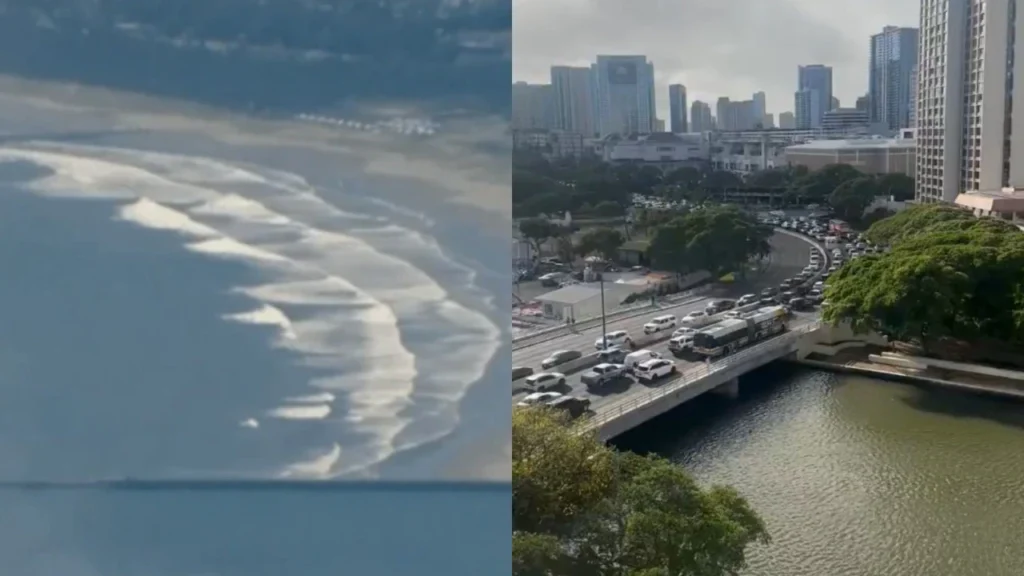
Japan and the US issued Tsunami Warnings
A powerful earthquake struck off the coast of Russia, triggering tsunami warnings across the Pacific and prompting urgent evacuations in Japan and the US. Authorities in both countries swiftly mobilized emergency response teams, directing coastal residents to move to higher ground as large waves threatened low-lying areas.
Magnitude 8.2 Earthquake Strikes Near Russia’s Kuril Islands
The U.S. Geological Survey (USGS) reported a massive 8.2-magnitude earthquake near the Kuril Islands, a remote archipelago between Russia and Japan. The quake, which struck at a depth of 10 kilometers (6.2 miles), sent shockwaves across the Pacific Ocean, raising immediate concerns of a destructive tsunami.
Japan’s Meteorological Agency (JMA) issued a major tsunami warning for Hokkaido and northern coastal regions, predicting waves as high as 3 meters (10 feet). The U.S. National Tsunami Warning Center also activated alerts for Hawaii, Alaska, and the West Coast, urging residents to stay vigilant.
Japan Orders Immediate Evacuations
Japanese authorities activated emergency protocols, broadcasting evacuation orders via loudspeakers, mobile alerts, and television broadcasts. Thousands of residents in Hokkaido, Aomori, and Iwate prefectures fled to designated shelters as sirens blared across coastal towns.
“We are urging all residents in at-risk areas to evacuate immediately,” said a JMA spokesperson. “Do not wait—move to higher ground now.”
Bullet train services in northern Japan were suspended, and airports temporarily halted flights as a precaution. The last major tsunami to hit Japan—the 2011 Tohoku disaster—killed nearly 20,000 people, making officials particularly cautious this time.
US West Coast and Hawaii on High Alert
Across the Pacific, the U.S. West Coast braced for potential impacts. The National Oceanic and Atmospheric Administration (NOAA) issued tsunami advisories for:
- Alaska (Aleutian Islands, Kodiak)
- California (San Francisco, Los Angeles)
- Oregon and Washington (Coastal zones)
- Hawaii (All islands)
In Hawaii, emergency sirens sounded, and civil defense teams directed beachgoers to evacuate. “We are monitoring the situation closely, but safety comes first,” said a Hawaii Emergency Management Agency official.
California’s Office of Emergency Services (Cal OES) activated coastal evacuation plans, warning of strong currents and possible flooding. “Even small waves can be dangerous,” a spokesperson cautioned.
Russia’s Far East Also Affected
The earthquake’s epicenter was close to Russia’s Sakhalin and Kuril Islands, where officials reported moderate shaking but no immediate major damage. Russian emergency services remained on standby, with tsunami warnings in effect for Sakhalin and Kamchatka.
Why This Earthquake Posed a Major Tsunami Risk
Tsunamis are most dangerous when:
- The earthquake is shallow (less than 70 km deep).
- The magnitude exceeds 7.5.
- The quake occurs underwater, displacing large volumes of water.
This quake met all three criteria, raising fears of a rapidly spreading tsunami. Fortunately, early warnings and swift evacuations helped mitigate risks.
Lessons from Past Disasters
Both Japan and the U.S. have strengthened tsunami preparedness since 2004’s Indian Ocean tsunami and Japan’s 2011 disaster. Key improvements include:
- Faster detection systems
- Automated public alerts
- Stricter building codes in tsunami zones
Current Status: Warnings Downgraded but Caution Remains
As of the latest updates, Japan has downgraded its tsunami warning but still advises caution. The U.S. has lifted most alerts but warns of lingering strong currents.
What Residents Should Do Now
- Stay away from beaches and harbors due to unpredictable waves.
- Follow local emergency instructions.
- Monitor official updates from JMA, USGS, and NOAA.
Conclusion
The major earthquake off Russia served as a critical test for global tsunami response systems. Thanks to rapid evacuations and advanced warnings, casualties were minimized. However, the event underscores the ongoing threat of Pacific Ring of Fire seismic activity—and the need for constant preparedness.
For real-time updates, check:
- Japan Meteorological Agency (www.jma.go.jp)
- U.S. Tsunami Warning System (tsunami.gov)
Stay safe, stay informed, and always heed evacuation orders.

